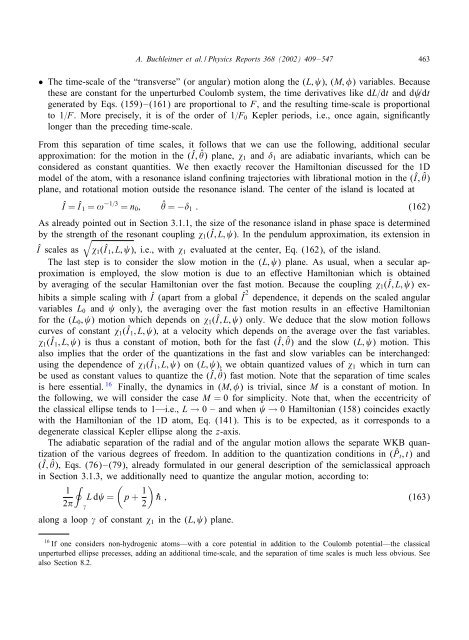Non-dispersive wave packets in periodically driven quantum systems
Non-dispersive wave packets in periodically driven quantum systems
Non-dispersive wave packets in periodically driven quantum systems
Create successful ePaper yourself
Turn your PDF publications into a flip-book with our unique Google optimized e-Paper software.
A. Buchleitner et al. / Physics Reports 368 (2002) 409–547 463<br />
• The time-scale of the “transverse” (or angular) motion along the (L; ), (M; ) variables. Because<br />
these are constant for the unperturbed Coulomb system, the time derivatives like dL=dt and d =dt<br />
generated by Eqs. (159)–(161) are proportional to F, and the result<strong>in</strong>g time-scale is proportional<br />
to 1=F. More precisely, it is of the order of 1=F0 Kepler periods, i.e., once aga<strong>in</strong>, signi cantly<br />
longer than the preced<strong>in</strong>g time-scale.<br />
From this separation of time scales, it follows that we can use the follow<strong>in</strong>g, additional secular<br />
approximation: for the motion <strong>in</strong> the (Î; ˆ ) plane, 1 and 1 are adiabatic <strong>in</strong>variants, which can be<br />
considered as constant quantities. We then exactly recover the Hamiltonian discussed for the 1D<br />
model of the atom, with a resonance island con n<strong>in</strong>g trajectories with librational motion <strong>in</strong> the (Î; ˆ )<br />
plane, and rotational motion outside the resonance island. The center of the island is located at<br />
Î = Î 1 = ! −1=3 = n0; ˆ = − 1 : (162)<br />
As already po<strong>in</strong>ted out <strong>in</strong> Section 3.1.1, the size of the resonance island <strong>in</strong> phase space is determ<strong>in</strong>ed<br />
by the strength of the resonant coupl<strong>in</strong>g 1(Î; L; ). In the pendulum approximation, its extension <strong>in</strong><br />
Î scales as 1(Î 1;L; ), i.e., with 1 evaluated at the center, Eq. (162), of the island.<br />
The last step is to consider the slow motion <strong>in</strong> the (L; ) plane. As usual, when a secular approximation<br />
is employed, the slow motion is due to an e ective Hamiltonian which is obta<strong>in</strong>ed<br />
by averag<strong>in</strong>g of the secular Hamiltonian over the fast motion. Because the coupl<strong>in</strong>g 1(Î; L; ) exhibits<br />
a simple scal<strong>in</strong>g with Î (apart from a global Î 2 dependence, it depends on the scaled angular<br />
variables L0 and only), the averag<strong>in</strong>g over the fast motion results <strong>in</strong> an e ective Hamiltonian<br />
for the (L0; ) motion which depends on 1(Î; L; ) only. We deduce that the slow motion follows<br />
curves of constant 1(Î 1;L; ); at a velocity which depends on the average over the fast variables.<br />
1(Î 1;L; ) is thus a constant of motion, both for the fast (Î; ˆ ) and the slow (L; ) motion. This<br />
also implies that the order of the quantizations <strong>in</strong> the fast and slow variables can be <strong>in</strong>terchanged:<br />
us<strong>in</strong>g the dependence of 1(Î 1;L; )on(L; ); we obta<strong>in</strong> quantized values of 1 which <strong>in</strong> turn can<br />
be used as constant values to quantize the (Î; ˆ ) fast motion. Note that the separation of time scales<br />
is here essential. 16 F<strong>in</strong>ally, the dynamics <strong>in</strong> (M; ) is trivial, s<strong>in</strong>ce M is a constant of motion. In<br />
the follow<strong>in</strong>g, we will consider the case M = 0 for simplicity. Note that, when the eccentricity of<br />
the classical ellipse tends to 1—i.e., L → 0 – and when → 0 Hamiltonian (158) co<strong>in</strong>cides exactly<br />
with the Hamiltonian of the 1D atom, Eq. (141). This is to be expected, as it corresponds to a<br />
degenerate classical Kepler ellipse along the z-axis.<br />
The adiabatic separation of the radial and of the angular motion allows the separate WKB quantization<br />
of the various degrees of freedom. In addition to the quantization conditions <strong>in</strong> ( ˆPt;t) and<br />
(Î; ˆ ), Eqs. (76)–(79), already formulated <strong>in</strong> our general description of the semiclassical approach<br />
<strong>in</strong> Section 3.1.3, we additionally need to quantize the angular motion, accord<strong>in</strong>g to:<br />
<br />
1<br />
L d = p +<br />
2<br />
1<br />
<br />
˝ ; (163)<br />
2<br />
along a loop of constant 1 <strong>in</strong> the (L; ) plane.<br />
16 If one considers non-hydrogenic atoms—with a core potential <strong>in</strong> addition to the Coulomb potential—the classical<br />
unperturbed ellipse precesses, add<strong>in</strong>g an additional time-scale, and the separation of time scales is much less obvious. See<br />
also Section 8.2.











